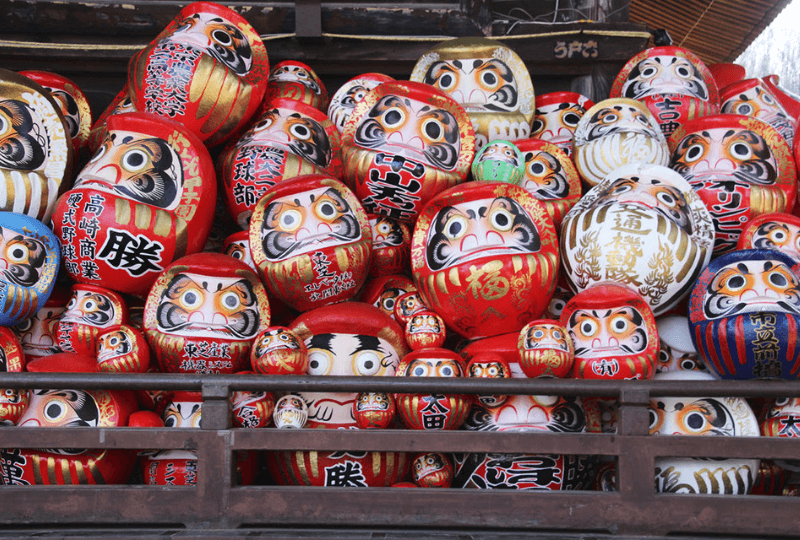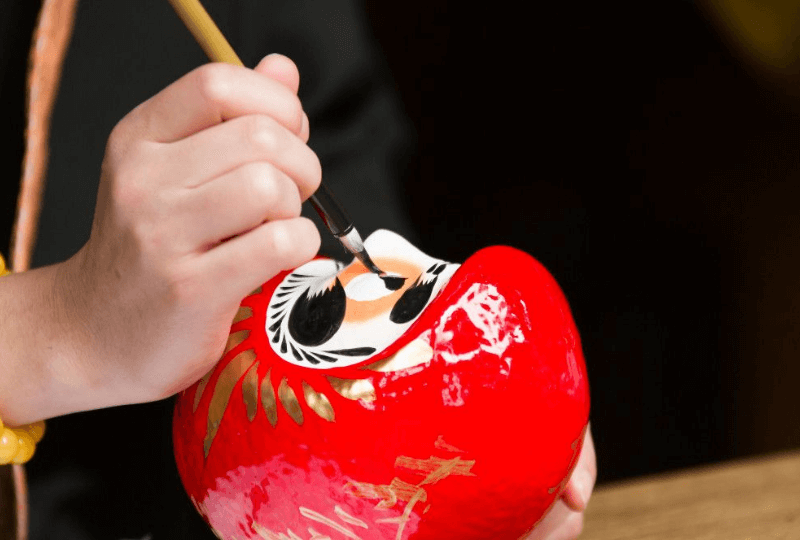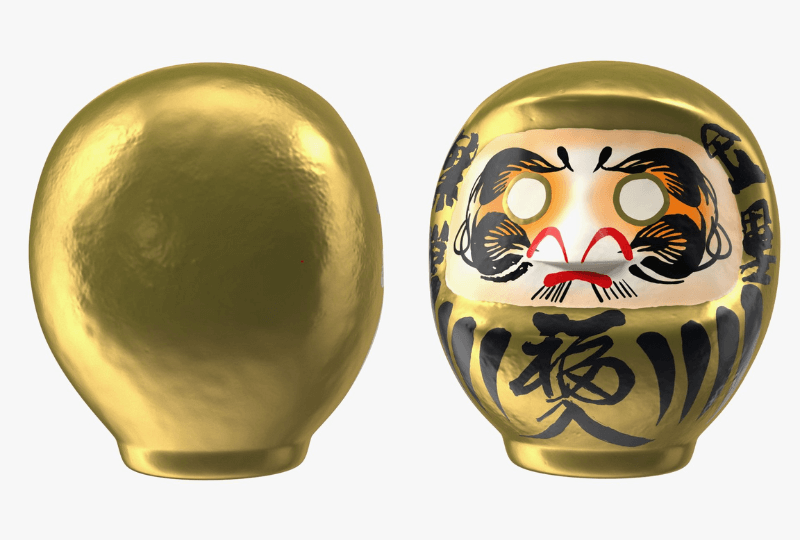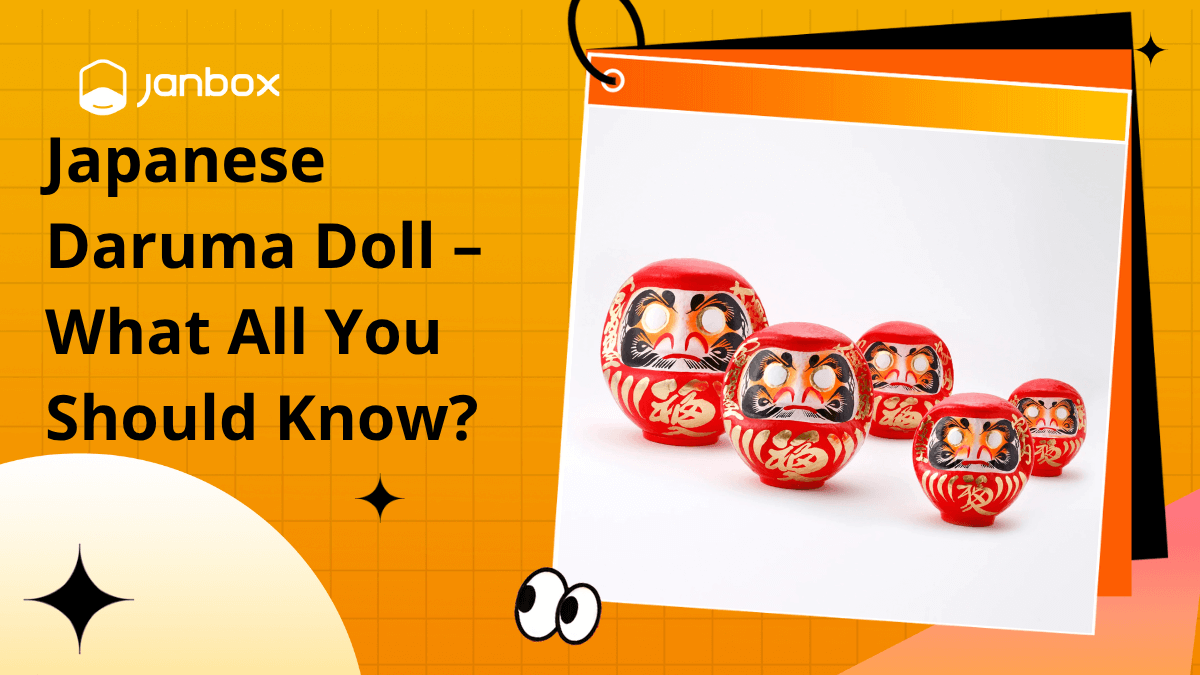One should be proud of Japan’s cultural diversity. Fans of Japanese fortunate charms and folklore enthusiasts have many reasons to be content thanks to myths and customs. This article will focus on the Japanese Daruma doll which is both intriguing in terms of its shape and its past. What about its past, though? Why does this doll lack both legs and arms? How can you make a wish come true using this Japanese Daruma doll? The remainder of this article will address many of the questions that were raised. Let’s get going!
1. What Is A Japanese Daruma Doll?
The Japanese Daruma doll is more than a quirky souvenir—it’s a cherished cultural symbol of perseverance and luck in Japan. Traditionally handcrafted, these round, hollow figures are often purchased around New Year, when markets overflow with bright red Darumas. Individuals and companies alike buy them to wish for personal success, business prosperity, or victory in elections.
After purchasing, one eye is drawn while making a wish or setting a goal. If the goal is achieved within the year, the second eye is filled in, and the doll is ceremonially returned to a shrine for burning. Whether the wish comes true or not, many follow the tradition of replacing their Daruma doll Japan each year, keeping the spirit of renewal alive.

2. The History And Origin Of Daruma Dolls
The Japanese Daruma doll traces its powerful symbolism back to Bodhidharma, a 5th–6th century monk credited with founding Zen Buddhism. According to legend, Bodhidharma meditated in a cave for nine years without moving, facing a wall in complete silence and discipline. During this intense practice, it’s said he lost the use of his arms and legs due to immobility, and even sliced off his eyelids to avoid sleep—a dramatic act of dedication. These stories inspired the Daruma’s iconic design: round, limbless, and with blank white eyes.
The physical form of the Daruma represents perseverance and resilience. Its armless, legless shape ensures it always rights itself when tipped over—mirroring the Zen proverb “fall seven times, stand up eight.”
The Daruma Doll Japan tradition began during the Edo period in Takasaki, Gunma Prefecture—still home to over 80% of Japan’s Daruma production today. Artisans at the Daruma-Dera temple created dolls as New Year charms for good fortune. This legacy continues through Takasaki’s annual Daruma Festival at Shorinzan Temple, celebrating the doll’s cultural and spiritual origins.

>>> Read more: The 17 Types of Japanese Traditional Dolls You Need To Know
3. Design And Features Of The Japanese Daruma Doll
The Japanese Daruma doll is instantly recognizable thanks to its rounded, hollow shape and bright, often red, exterior. This traditional good luck charm is weighted at the bottom, allowing it to return to an upright position when tilted—a physical representation of the resilience and determination it symbolizes.
A closer look at Japanese Daruma dolls reveals bold, expressive facial features. The eyes are intentionally left blank, meant to be filled in by the owner when making and achieving a goal. The thick eyebrows and facial hair are stylized to resemble Bodhidharma, the Zen monk who inspired the design—often interpreted as a crane and turtle, symbols of longevity in Japanese folklore.
Traditionally, Daruma dolls are made from papier-mâché using wooden molds, though modern versions may be crafted from plastic or wood for durability. Despite variations in color or style, every Daruma retains the same core design principles: balance, symbolism, and craftsmanship rooted in Japanese culture.
4. The Symbolism And Meaning Of Daruma Dolls
At the heart of the Daruma Japanese tradition lies deep cultural symbolism rooted in perseverance, resilience, and the pursuit of personal goals. The Daruma doll is not just a decorative item—it’s a motivational tool that embodies the Japanese spirit of gambaru, or unwavering determination.
One of the most meaningful customs associated with Daruma dolls is the eye-painting ritual. When a goal is set, the owner paints in one of the doll’s blank eyes. Once the goal is achieved, the second eye is filled in—symbolizing both accomplishment and gratitude. This powerful visual commitment encourages individuals to stay focused and persevere through challenges.
The Daruma Japanese design—sturdy, limbless, and weighted to always return upright—reinforces its core message: “Fall down seven times, get up eight.” As such, Daruma dolls have become enduring symbols of good fortune and personal growth, cherished not only in Japan but around the world.
5. How to Make a Wish with a Japanese Daruma Doll
Making a wish with a Japanese Daruma doll is both a meaningful ritual and a powerful tool for goal-setting. Follow these steps to use your Daruma with intention:

- Choose the Right Daruma Doll: Select a doll based on color and purpose. Red is most common, symbolizing good luck and general success. Other colors represent specific goals—gold for wealth, white for love, green for health, etc.
- Set a Clear, Achievable Goal: Think deeply about a personal or professional goal. Clarity is key—it should be realistic and motivating.
- Paint the First Eye: Using a black marker or brush, fill in the left eye while visualizing your goal. This act commits your intention to action.
- Display Your Daruma: Place the doll somewhere visible—on your desk, shelf, or altar—as a daily reminder to stay focused.
- Paint the Second Eye: Once you achieve your goal, celebrate by painting in the right eye. This completes the ritual.
- Return It to a Temple (Optional): According to Daruma doll Japan tradition, many return their Daruma to a temple at year’s end for ceremonial burning.
>>> Read more: Top 10 Best Japanese Traditional Toys You Should Not Miss
6. Color Meanings of Japanese Daruma Dolls
Japanese Daruma dolls are renowned for their vibrant colors, each representing specific wishes or blessings in Japanese culture. These colors allow users to select a doll aligned with their personal goals, from prosperity to peace. This section explores the symbolism behind each hue, helping readers choose the perfect Daruma for their aspirations.
6.1 Red: Good Luck and Protection
Red is the most iconic color for Japanese Daruma dolls, symbolizing good luck and protection from evil spirits. Rooted in traditional beliefs, red Darumas are often used for general fortune or to ward off misfortune. They are a popular choice for New Year’s wishes.
6.2 Purple: Health and Longevity
Purple Japanese Daruma dolls represent health and longevity, making them ideal for those seeking wellness or a long life. This color is often gifted to elders or used in prayers for recovery. Its calming hue reflects a focus on physical and mental well-being.
6.3 Gold: Wealth and Prosperity
Gold Japanese Daruma dolls are associated with wealth and prosperity, appealing to those pursuing financial success. Often placed in businesses or homes, they symbolize abundance and economic growth. The radiant color embodies optimism for financial goals.

6.4 Black: Success in Business or Career
Black Japanese Daruma dolls signify success in business or career endeavors. Chosen by entrepreneurs or professionals, they represent ambition and achievement. The bold color underscores determination in competitive fields.
6.5 White: Purity and Peace
White Japanese Daruma dolls symbolize purity and peace, often used for spiritual or emotional harmony. They are popular in settings seeking tranquility, such as meditation spaces. This color reflects a desire for clarity and serenity.
6.6 Green: Vitality and Energy
Green Japanese Daruma dolls, though less common, represent vitality and energy. They are chosen by those seeking renewed vigor or personal growth. This vibrant hue inspires enthusiasm and dynamism.
For an interactive twist, try a “Daruma color quiz” to match your life goals with the perfect Daruma color, enhancing your connection to this cultural tradition.
7. Creative Decoration Ideas Using Japanese Daruma Dolls
Integrating a Japanese Daruma doll into your living or working space is a meaningful way to blend tradition with inspiration. In the home, these dolls can serve as powerful focal points when placed on shelves, personal altars, or desks—reminding you daily of your goals and perseverance. In office environments, Japanese Daruma dolls are popular motivational symbols, encouraging focus and determination in professional settings.
For a truly unique touch, consider creating a “Daruma wall”—a vibrant display of multicolored Daruma dolls, each representing a specific goal or life area (e.g., red for luck, gold for prosperity). This not only brightens your space but visually reflects your aspirations.
Seasonally, Daruma dolls are perfect additions to New Year or festival decorations. Whether used individually or in themed arrangements, they bring cultural depth, positive energy, and a touch of color to any environment—turning your decor into a source of inspiration and intention.
>>> Read more: What is a Maneki Neko? Everything you need to know (2022)
8. Where To Buy Daruma Dolls?
There are numerous traditional Daruma craft stores and factories in Takasaki, Gunma, which is where more than 80% of all Darumas in Japan are produced. The Darumas are handmade and hand-painted at a variety of shops that you can visit. You may even create your Japanese Daruma doll if you enjoy arts and crafts.

Numerous Daruma dolls are frequently offered for sale at year-end festivals held by temples or cities. You can purchase a new Daruma doll at these festivals and bring your old ones in to be ceremonially burned. Yoshida Daruma is available for purchase online in a variety of forms.
The Happy Daruma brand of daruma dolls is popular in Tokyo. Japanese Daruma doll can be purchased in Kyoto via a regional online retailer called Kimura Oshida. There, you may order your preferred daruma doll online and have it delivered to you. If you would prefer to purchase a daruma in person while in Kyoto, you can do so at the Kyoto Handicraft Center. Kyoto also features a distinctive Buddhist temple called Horin-Ji, but due to its vast collection of 8,000 donated daruma dolls, it is also known as Daruma-Dera.
>>> Read more: How to buy from Surugaya with Janbox Japan
9. Conclusion
What is a daruma doll? The doll, which is frequently presented as a gift, represents Bodhidharma’s commitment to meditation, perseverance, and accomplishing personal objectives. Daruma in Japanese culture has a long history, however, the Japanese Daruma doll is still used in Japan for good luck and is also used as an award for success today.
- Website: https://janbox.com
- Email: [email protected]








